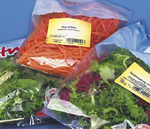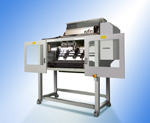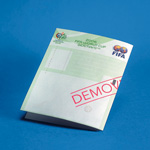5 May 2011
Laser perforations open up new possibilities
Micron sized holes produced by lasers have become an essential part of many manufacturing processes. Often difficult to see with the naked eye, these tiny apertures are used in packaging to control and extend the shelf life of many fresh products, improve the efficiency of filter tips for cigarettes and even enhance anti-counterfeit measures on event tickets, security passes and passports.
Whilst we might think of these as just humble holes, the reality is quite different. Hole size, shape and position are controlled to micron dimensions, providing the specific functionality required for a diverse range of applications.
Rofin Lasers Star in Packaging
 Modified atmosphere packaging (MAP) is an excellent example of how the flexibility of the laser perforation process can be used to good effect. This type of packaging is used to increase the shelf life of fresh and refrigerated food products. For perishable food in particular, shelf-life has a great influence on its value. The growth in the healthy foods and snacks markets has driven the requirement for not only attractive presentation, but extended shelf life for products such as organic fruit, vegetables, nuts, dried fruit and cereals. The freshness of these products is largely determined by air-ventilation and the preservation of humidity within the packaging.
Modified atmosphere packaging (MAP) is an excellent example of how the flexibility of the laser perforation process can be used to good effect. This type of packaging is used to increase the shelf life of fresh and refrigerated food products. For perishable food in particular, shelf-life has a great influence on its value. The growth in the healthy foods and snacks markets has driven the requirement for not only attractive presentation, but extended shelf life for products such as organic fruit, vegetables, nuts, dried fruit and cereals. The freshness of these products is largely determined by air-ventilation and the preservation of humidity within the packaging.
An additional requirement has also arisen for multi-chamber trays used for multi-component snacks. For these products each chamber requires perforating differently to optimise the storage life of the ingredients within that particular chamber. To achieve these ever growing demands, lasers are increasingly becoming an integral part of the production process.
The packaging materials used in these applications are often produced in a continuous process and at high speeds. To maximise the efficiency of the packaging film it is essential that the laser-produced holes are of the accuracy required to allow the specified air exchange to take place. If not properly controlled the laser perforation process could produce oval or inconsistent shapes and sizes, rendering the material inefficient at best and at worst, unusable.
 To eliminate inconsistency problems and match web speeds which can reach 500m per minute, Rofin has developed the StarPack range of laser systems which provide solutions for both web direction and cross web applications. In addition, Rofin’s Web Movement Compensation System (WMC) has the capability to control and optimise the perforation hole dimensions, ensuring consistency and further enhancing the shelf life of fresh food products. This means less waste, lower costs and ultimately more attractive pricing for the customer.
To eliminate inconsistency problems and match web speeds which can reach 500m per minute, Rofin has developed the StarPack range of laser systems which provide solutions for both web direction and cross web applications. In addition, Rofin’s Web Movement Compensation System (WMC) has the capability to control and optimise the perforation hole dimensions, ensuring consistency and further enhancing the shelf life of fresh food products. This means less waste, lower costs and ultimately more attractive pricing for the customer.
Lasers have also proven to be the ideal solution for Selective Weakening / Easy Opening applications in packaging. The capability of the laser to “select” a particular film layer(s) to scribe enables the generation of precise easy opening tear lines, whilst leaving other layers that are required to protect the product from light and humidity, intact. Rofin lasers can even be used to scribe freeform lines, for example following a contour on the print therefore providing new inspiration and ideas for packaging designers. Laser generated easy open features, which can have as many as 50 holes/cm, provide a consistent opening force, avoiding the spills and even minor injuries which can result from the sometimes inconsistent quality of mechanically created opening features.
Lasers Protect Against Forgery and Enhance Security
Lasers have also proven to be an indispensible tool in the fight against forgery. The ability of the laser to produce consistent and accurate micron sized holes in unique patterns provides enhanced protection against forgery in official documents such as passports. Although a passport contains many complex security features including, bio-data, watermarks, hologram images and security details visible only under certain lighting conditions, the laser provides yet another level of protection.
Many new passports now also contain a series of laser drilled holes, used to re-produce the passport number adjacent to the printed text and also drill a precise series of holes through a number of sequential pages. The latter feature makes it almost impossible for a passport document that has been modified or tampered with by removing or inserting pages, to pass as an original document, as the holes on the various pages could never be re-aligned to the original precision created by the laser.
Large sporting events such as World Cup Championships and the forthcoming London Olympics draw very large crowds, subsequently placing a heavy burden of responsibility for safety and security on the organisers. At all major events of this type, security measures for officials, competitors, high profile guests and employees have to be strict to ensure that only persons holding valid access passes are able to enter the venue or gain access to certain restricted areas.
As a leader in providing laser solutions for passport, event ticketing and ID card perforation, Rofin has been involved in many high profile events in recent years. Rofin engineers work closely with the company chosen to produce the tickets and passes for a specific event, to define a pattern of perforations, some of which would be easily visible to the eye and some which would be much more difficult to detect. These perforations significantly increase the security features of the item, as only the event security staff would know of the presence and precise location of these very small holes, making official passes and tickets more difficult to counterfeit.
 The perforation pattern generated by Rofin Lasers for a Championship Football Tournament was in the form of a football, with additional perforation holes and lines in the area of the pass which incorporated the owners photograph. The laser perforations in this area made it impossible to remove the original picture without damaging the parent material. A three axis Galvo Head was used to cover the 300mm x 300mm working area required for 2 Passes. Even with this large working envelope the laser produced perforated holes as small as 200 microns, and completed the perforation process for two tickets in just 1 second.
The perforation pattern generated by Rofin Lasers for a Championship Football Tournament was in the form of a football, with additional perforation holes and lines in the area of the pass which incorporated the owners photograph. The laser perforations in this area made it impossible to remove the original picture without damaging the parent material. A three axis Galvo Head was used to cover the 300mm x 300mm working area required for 2 Passes. Even with this large working envelope the laser produced perforated holes as small as 200 microns, and completed the perforation process for two tickets in just 1 second.
Clearly, the not so humble hole, generated in millions every day by Rofin lasers, plays a significant part in our everyday lives from maintaining the freshness of our food, to enhancing safety and security at our borders and at major public events.
- Contact Information
- Name: Dave MacLellan
- Email: sales@rofin-baasel.co.uk
- Website: www.rofin.co.uk

